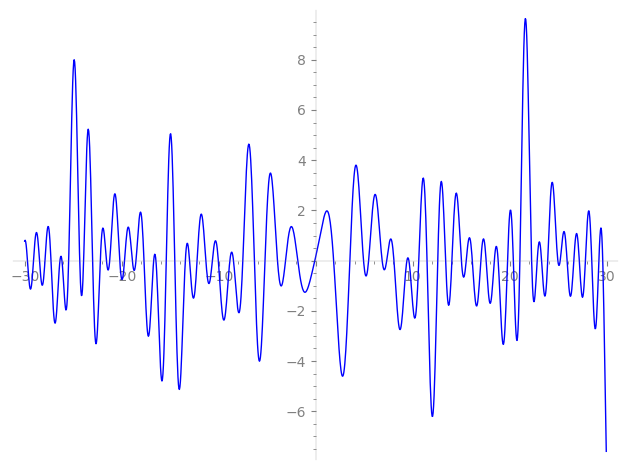| L(s) = 1 | + (−0.726 − 1.21i)2-s + (−0.944 + 1.76i)4-s + (−0.256 − 0.148i)5-s + (−0.866 + 0.5i)7-s + (2.82 − 0.135i)8-s + (0.00667 + 0.418i)10-s + (−2.21 − 3.83i)11-s + (−0.227 + 0.393i)13-s + (1.23 + 0.687i)14-s + (−2.21 − 3.32i)16-s + 6.53i·17-s − 1.47i·19-s + (0.503 − 0.312i)20-s + (−3.04 + 5.47i)22-s + (2.09 − 3.62i)23-s + ⋯ |
| L(s) = 1 | + (−0.513 − 0.857i)2-s + (−0.472 + 0.881i)4-s + (−0.114 − 0.0662i)5-s + (−0.327 + 0.188i)7-s + (0.998 − 0.0477i)8-s + (0.00210 + 0.132i)10-s + (−0.668 − 1.15i)11-s + (−0.0630 + 0.109i)13-s + (0.330 + 0.183i)14-s + (−0.554 − 0.832i)16-s + 1.58i·17-s − 0.338i·19-s + (0.112 − 0.0698i)20-s + (−0.649 + 1.16i)22-s + (0.436 − 0.755i)23-s + ⋯ |
\[\begin{aligned}\Lambda(s)=\mathstrut & 756 ^{s/2} \, \Gamma_{\C}(s) \, L(s)\cr =\mathstrut & (-0.834 - 0.551i)\, \overline{\Lambda}(2-s) \end{aligned}\]
\[\begin{aligned}\Lambda(s)=\mathstrut & 756 ^{s/2} \, \Gamma_{\C}(s+1/2) \, L(s)\cr =\mathstrut & (-0.834 - 0.551i)\, \overline{\Lambda}(1-s) \end{aligned}\]
Particular Values
| \(L(1)\) |
\(\approx\) |
\(0.0458787 + 0.152704i\) |
| \(L(\frac12)\) |
\(\approx\) |
\(0.0458787 + 0.152704i\) |
| \(L(\frac{3}{2})\) |
|
not available |
| \(L(1)\) |
|
not available |
\(L(s) = \displaystyle \prod_{p} F_p(p^{-s})^{-1} \)
| $p$ | $F_p(T)$ |
|---|
| bad | 2 | \( 1 + (0.726 + 1.21i)T \) |
| 3 | \( 1 \) |
| 7 | \( 1 + (0.866 - 0.5i)T \) |
| good | 5 | \( 1 + (0.256 + 0.148i)T + (2.5 + 4.33i)T^{2} \) |
| 11 | \( 1 + (2.21 + 3.83i)T + (-5.5 + 9.52i)T^{2} \) |
| 13 | \( 1 + (0.227 - 0.393i)T + (-6.5 - 11.2i)T^{2} \) |
| 17 | \( 1 - 6.53iT - 17T^{2} \) |
| 19 | \( 1 + 1.47iT - 19T^{2} \) |
| 23 | \( 1 + (-2.09 + 3.62i)T + (-11.5 - 19.9i)T^{2} \) |
| 29 | \( 1 + (5.71 - 3.30i)T + (14.5 - 25.1i)T^{2} \) |
| 31 | \( 1 + (5.73 + 3.31i)T + (15.5 + 26.8i)T^{2} \) |
| 37 | \( 1 + 7.53T + 37T^{2} \) |
| 41 | \( 1 + (1.57 + 0.906i)T + (20.5 + 35.5i)T^{2} \) |
| 43 | \( 1 + (8.80 - 5.08i)T + (21.5 - 37.2i)T^{2} \) |
| 47 | \( 1 + (3.32 + 5.76i)T + (-23.5 + 40.7i)T^{2} \) |
| 53 | \( 1 + 1.22iT - 53T^{2} \) |
| 59 | \( 1 + (6.57 - 11.3i)T + (-29.5 - 51.0i)T^{2} \) |
| 61 | \( 1 + (-1.86 - 3.23i)T + (-30.5 + 52.8i)T^{2} \) |
| 67 | \( 1 + (-0.941 - 0.543i)T + (33.5 + 58.0i)T^{2} \) |
| 71 | \( 1 - 1.66T + 71T^{2} \) |
| 73 | \( 1 - 3.76T + 73T^{2} \) |
| 79 | \( 1 + (-4.13 + 2.38i)T + (39.5 - 68.4i)T^{2} \) |
| 83 | \( 1 + (4.93 + 8.54i)T + (-41.5 + 71.8i)T^{2} \) |
| 89 | \( 1 + 11.2iT - 89T^{2} \) |
| 97 | \( 1 + (-5.52 - 9.57i)T + (-48.5 + 84.0i)T^{2} \) |
| show more | |
| show less | |
\(L(s) = \displaystyle\prod_p \ \prod_{j=1}^{2} (1 - \alpha_{j,p}\, p^{-s})^{-1}\)
Imaginary part of the first few zeros on the critical line
−10.03965481147035648309134801625, −8.850274710500324682487506023107, −8.476842876399993351712879581463, −7.51544573331793553913227043972, −6.32443733950930569156895701843, −5.23332304314576691170426671125, −3.94180896769483732101601094860, −3.11322184413515179488412869481, −1.85078555902165336850367397724, −0.092579773453221573454321182169,
1.84603101332692541544727490025, 3.51631535381383255303854391594, 4.92815236415348164050180043168, 5.45082282642984269316559360323, 6.84769243894628311480128071447, 7.31667404314519970600983256718, 8.061942436312371904505069059140, 9.399457591298850207889315582757, 9.604480310219266530920038458997, 10.62071190967607327611752187849

